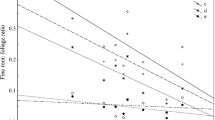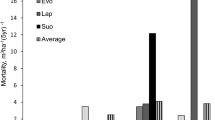Summary
The yield level of a stand of a given species expresses quantatively the potentiality of a site to produce wood. The General Yield Level is defined as the relative total production per unit area for a given mean-or top height. The so-called Specific Yield Level specifies the variation in the total volume production of stands of a given age and site quality class. The author’s studies in stands of scots pine reveal that the total volume production in stands of a given height varies as much as 20%. Yield levels above the average are found on dry sites, those below the average on loamy soils with a high soil water level.Assmann’s studies in spruce stands, however, revealed the occurrence of relatively high yield levels on loamy soils with a favourable soil moisture regime. In addition to soil moisture regime, the yield level of a stand is affected by the duration of the growing season and by rooting habits of the species.
Similar content being viewed by others
Literatur
Assmann, E., 1955: Zur Bonitierung süddeutscher Fichtenbestände. AFZ10, 61–64.
Ders.Assmann, E., 1961: Waldertragskunde. BLV Verlagsgesellschaft München-Bonn-Wien.
Erteld, W., 1961: Die Zuwachsleistung der Kiefer im Lichte neuerer Untersuchungen. Arch. f. Forstwes.10, 383–396.
Franz, F., 1960: Standort und Ertragsleistung bei der Kiefer. Tagungsbericht Nr. 26 der deutschen Akademie der Landwirtschaftswissenschaften zu Berlin.
Ders.Franz, F., 1972: Ertagskundliche Modellgrundlagen für die Wirtschaftlichkeitsschätzung von Forstdüngungsmaßnahmen (unveröff. Vortragsms.).
Kälble, F., 1966: Ertragskundliche und waldbauliche Auswertung der Standortskartierung im Badischen Bodenseegebiet. Schriftenr. d. Landesforstverw. Bd.-Wttbg., 22.
Kennel, R., 1971: Die Konstruktion von Ertragstafeln mit Hilfe von Durchmesserverteilungen und Einheitshöhenkurven. Forstw. Cbl.90, 117–128.
Kramer, H., 1966: Zum Wachstum der Fichte (Picea abies) in Großbritannien. AFJZ137, 53–67.
Magin, R., 1957: Über die Ursachen der Leistungsunterschiede beim Anbau fremdländischer Baumarten. AFZ.
Mitscherlich, G., 1963: Das Wachstum der Fichte in Europa. AFJZ.
Moosmayer, H. U., 1962: Ertragskundlich-standortskundliche Arbeiten in der deutschsprachigen Literatur nach 1945. Mittlg. d. Vereins. f. Forstl. Standortskunde12, 53–64.
—Ders., 1962: Die ertragskundlich-standortskundliche Auswertung der Forsteinrichtungsunterlagen. Mittlg. des Vereins für Forstl. Standortskunde und Forstpflanzenzüchtung16, 1–70.
Schmidt, A., 1971: Wachstum und Ertrag der Kiefer auf wirtschaftlich wichtigen Standortseinheiten der Oberpfalz. Forschungsber. der FFA München, Bd. 1.
Schober, R., 1955: Die Ertragsleistung der Nadelhölzer in Großbritannien und in Deutschland. Forstw. Cbl.
Author information
Authors and Affiliations
Rights and permissions
About this article
Cite this article
Schmidt, A. Ertragsniveau und Standort dargestellt am Beispiel der Kiefer. Forstw Cbl 92, 268–274 (1973). https://doi.org/10.1007/BF02736058
Published:
Issue Date:
DOI: https://doi.org/10.1007/BF02736058




